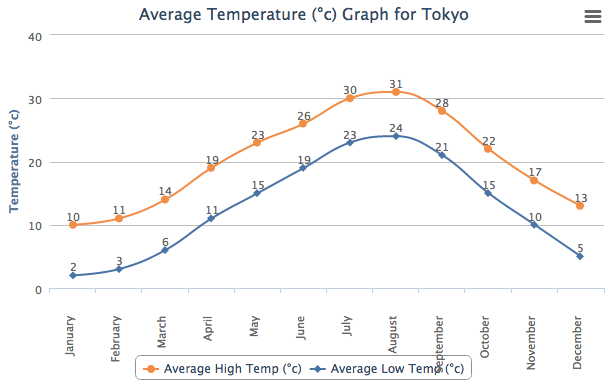Tokyo Weather
Tokyo weather overview : the bustling capital of Japan, experiences a dynamic range of weather conditions throughout the year, making it a fascinating subject for tourists, expatriates, and locals alike. Understanding Tokyo’s weather is crucial for planning travel, activities, and even daily commutes. This guide offers an in-depth look at the climate in Tokyo, providing valuable insights into what you can expect during your visit or stay.
The Four Seasons in Tokyo
Spring (March to May) is one of the most celebrated times in Tokyo. The weather gradually warms up, and the city is adorned with the iconic cherry blossoms, or sakura, drawing crowds to parks for hanami (flower viewing) parties. Temperatures range from 10°C to 20°C (50°F to 68°F), making it a pleasant time for sightseeing and outdoor festivals.
Summer (June to August) introduces a hot and humid climate, with temperatures often climbing above 30°C (86°F). This season is marked by vibrant festivals, fireworks, and the Bon Odori dance to honor ancestors. Despite the heat, it’s a lively time to experience Tokyo’s energetic summer spirit. The rainy season, typically in early summer, brings brief showers, providing a cool respite.
Autumn (September to November) is a favorite for many, as the heat of summer gives way to cooler, crisp air and the stunning koyo (autumn leaves). Temperatures range from 15°C to 25°C (59°F to 77°F). Parks and gardens become canvases of red, orange, and yellow leaves, offering picturesque scenes for walks and photography.
Winter (December to February) is relatively mild with occasional snowfall, and temperatures hover around 5°C to 12°C (41°F to 54°F). The season is festive with illuminations and New Year celebrations. While it’s the coldest time of the year, the clear days and winter activities make it a unique time to visit.
Each season in Tokyo offers a different palette of experiences, from the delicate sakura of spring to the vivid leaves of autumn, making it a year-round destination for travelers and locals alike.
Tokyo Weather : Patterns and Phenomena
Tokyo’s climate is not just about the distinct changes each season brings; it’s also characterized by specific weather patterns and phenomena that significantly impact the city’s daily life and the plans of its residents and visitors. Understanding these patterns is crucial for navigating the city comfortably and safely.
The rainy season, known as tsuyu, occurs in early summer (June to July). It brings with it increased humidity and daily showers that can last for a few weeks. This period is marked by the blooming of hydrangeas, adding a splash of color to the cityscape. While the rain may seem relentless, it is also a time of renewal and lush greenery, offering a different perspective on the city’s beauty.
Typhoons are another significant weather phenomenon, typically affecting Tokyo from late summer to early autumn (August to October). These powerful storms can bring strong winds and heavy rainfall, leading to disruptions in transportation and outdoor activities. Being prepared and staying informed about weather advisories during this time is essential for safety.
Additionally, Tokyo experiences unusual weather patterns, such as sudden heatwaves during summer and occasional snowfall in winter, albeit less frequently than in other parts of Japan. These anomalies can catch people off guard, emphasizing the importance of staying updated with the latest weather forecasts.
Despite these challenges, the weather patterns and phenomena in Tokyo contribute to the city’s dynamic character. They shape the experiences of those who live in or visit Tokyo, offering opportunities to witness the resilience and adaptability of the city and its people.
Tips for Travelers
Navigating Tokyo’s diverse weather conditions requires some preparation to ensure a comfortable and enjoyable visit. Here are essential tips for travelers:
- Check the Weather Regularly: Tokyo’s weather can change rapidly, especially during the rainy season and typhoon periods. Use reliable weather apps or websites for the latest forecasts to plan your day accordingly.
- Dress Appropriately: Layers are key. Spring and autumn may require a light jacket or sweater, while summer demands breathable, light clothing to combat the heat and humidity. In winter, a warm coat, scarves, and gloves are necessary as temperatures can drop, especially at night.
- Stay Hydrated: The Japanese summer can be particularly brutal with its high humidity. Carry a reusable water bottle to stay hydrated, and take advantage of the numerous vending machines and convenience stores for refreshments.
- Carry a Portable Umbrella or Raincoat: During the rainy season and unpredictable showers in other seasons, having a compact umbrella or raincoat at hand is invaluable.
- Be Prepared for Typhoons: If traveling during typhoon season, stay informed about any weather warnings, and understand it may affect public transportation and outdoor activities. It’s wise to have a flexible itinerary during this time.
By following these tips and staying informed, travelers can comfortably enjoy the beauty and excitement of Tokyo, regardless of the season or weather conditions.
Conclusion : Tokyo Weather
Tokyo Weather summary : Understanding and preparing for Tokyo’s diverse weather conditions is crucial for anyone planning to visit or reside in this vibrant city. Each season offers a unique charm, from the serene beauty of cherry blossoms in spring to the colorful tapestry of autumn leaves. However, the city’s weather patterns, including the rainy season and typhoon threats, require visitors to stay informed and adaptable. By dressing appropriately, staying hydrated, and keeping abreast of weather forecasts, travelers can ensure a pleasant experience in Tokyo. Whether you’re exploring ancient temples, enjoying the bustling city life, or attending seasonal festivals, being prepared for Tokyo’s weather will enhance your enjoyment and appreciation of this dynamic city. Remember, Tokyo’s weather is a significant part of its character, adding depth and variety to the experiences it offers throughout the year.
Go Back to Various Page
E-Book Travel Coyotrip



